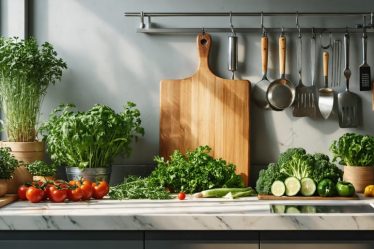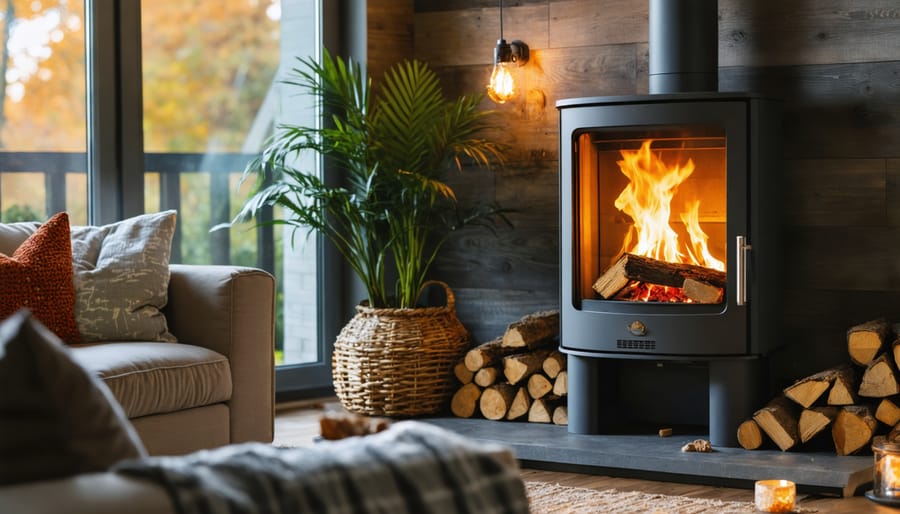
Transform your pellet stove into a heating powerhouse by adopting a mindful approach to energy efficiency. Clean the burn pot daily to prevent ash buildup, which can reduce heat output by up to 30%. Select premium-grade pellets with less than 1% ash content and moisture levels below 8% to maximize burn efficiency. Position your stove strategically – ideally in the home’s most frequently used area – to optimize heat distribution throughout your living space. Understanding these fundamentals not only cuts heating costs but also extends your stove’s lifespan, making it a reliable warmth source for years to come. Like any cherished home investment, a well-maintained pellet stove rewards you with consistent, cost-effective comfort while reducing your environmental footprint.
How Your Pellet Stove Actually Works
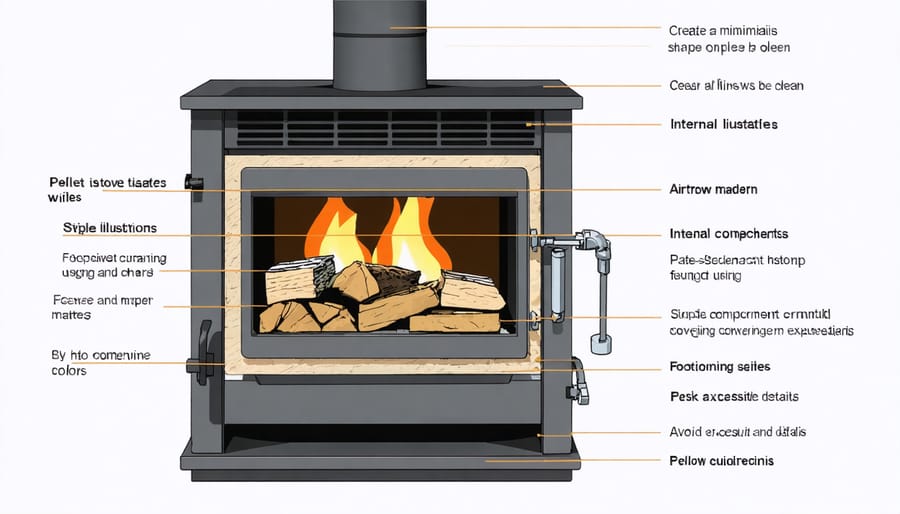
The Science Behind Clean Burning
Ever wondered why pellet stoves are such efficient heaters? The secret lies in their sophisticated combustion process, which reminds me of my grandmother’s wisdom about “waste not, want not.” Unlike traditional wood stoves, pellet stoves create an ideal environment for complete burning, meaning more heat and less waste.
Think of it as a perfectly choreographed dance between three elements: fuel, oxygen, and heat. The pellets, made from compressed sawdust and wood byproducts, are automatically fed into the burn pot in small, controlled amounts. Meanwhile, a fan introduces just the right amount of oxygen, creating an optimal air-to-fuel ratio. This precise control is what makes pellet stoves so efficient – they’re like having a tiny, well-managed bonfire in your home!
The high temperatures achieved in the burn chamber (usually around 1,500°F) ensure that nearly all the wood material converts to heat energy, leaving minimal ash behind. Plus, the automated feed system means you’re always burning just what you need, when you need it. It’s like having a smart thermostat for your wood-burning needs!
Maximizing Your Pellet Stove’s Performance
Quality Matters: Choosing the Right Pellets
Just like choosing the right ingredients for your favorite recipe, selecting quality pellets is crucial for your stove’s performance. I learned this lesson the hard way when I initially bought bargain pellets that left my stove underperforming and my living room less than cozy. Now, I know better!
Look for pellets with a Premium or Super Premium grade label – these typically have lower ash content and higher heat output. The best pellets should feel dense and have a smooth, glossy surface. Avoid bags with excessive sawdust at the bottom, as this often indicates poor quality or damaged pellets.
Storage is equally important for maintaining pellet quality. Keep your pellets in a dry, covered area – I use my garage, but any moisture-free space works well. Think of it as practicing efficient resource management – proper storage prevents waste and ensures your pellets perform at their best.
Pro tip: Buy your pellets during the off-season (spring or summer) when prices are typically lower. I like to stock up enough for the entire heating season, usually about 2-3 tons for my home. Just remember to rotate your stock, using older pellets first to maintain freshness and optimal burning efficiency.
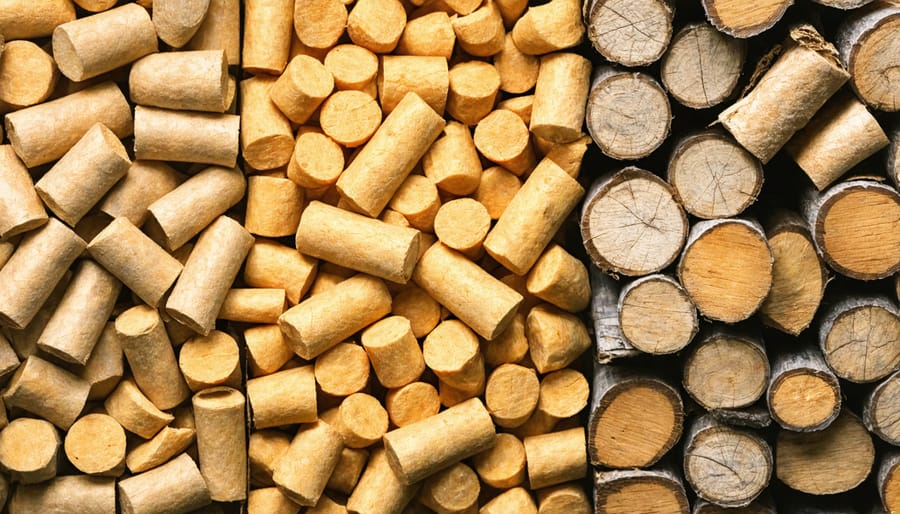
Simple Maintenance for Better Efficiency
Just like any cherished home appliance, your pellet stove needs regular TLC to perform at its best. I learned this firsthand when my own stove started acting up last winter – a simple cleaning made all the difference! Let me share some maintenance rituals that’ll keep your stove running efficiently.
Start with a daily quick-clean of the burn pot. I like to do this while enjoying my morning coffee – simply scrape out any ash build-up and clear the air holes. Once a week, give the viewing glass a gentle wipe-down with a soft cloth and approved cleaner. This not only keeps your flame view beautiful but also helps you monitor the fire quality.
Monthly maintenance is where the magic happens. Empty the ash pan completely (pro tip: wait until it’s completely cool!), and vacuum around the fan and vent areas. Don’t forget to inspect the door gasket – a tight seal means better efficiency. I keep a maintenance calendar on my phone to stay on track with these tasks.
Twice a year, schedule a deeper clean. Remove and clean the exhaust system, and check all mechanical parts. If you’re like me and prefer leaving the technical stuff to experts, consider booking a professional inspection before each heating season. Trust me, this investment pays for itself in better performance and peace of mind!
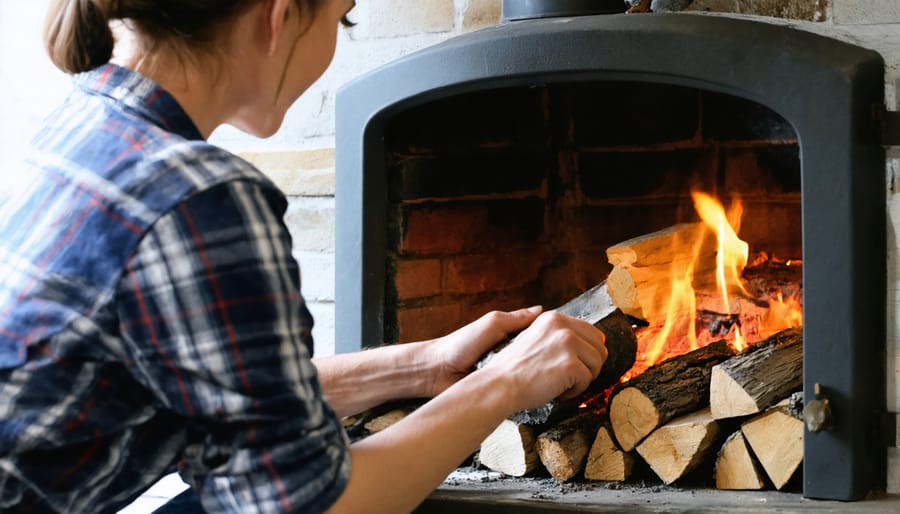
Smart Operating Techniques
Temperature Control Tips
Finding the sweet spot for your pellet stove’s temperature settings can feel like a bit of a puzzle at first, but I promise it gets easier with practice! I’ve learned that the key is to start with a medium heat setting and adjust gradually based on your comfort level and the outside temperature.
For most homes, setting your stove between 65-72°F (18-22°C) provides comfortable warmth while maintaining efficiency. I always recommend using your stove’s built-in thermostat if it has one – it’s like having a helpful assistant that maintains consistent temperatures throughout the day.
Here’s a tip that transformed my experience: instead of cranking up the heat when you’re cold, try adjusting the fan speed first. A lower temperature with better air circulation often feels just as cozy and uses less fuel. During milder days, running your stove on the lowest setting can provide gentle, steady warmth without overheating your space.
Remember to give your stove about 20-30 minutes to adjust after changing settings – patience really pays off when it comes to finding that perfect temperature balance!
Timing Your Usage
Just like planning your weekly meal prep, timing your pellet stove usage can make a huge difference in your home’s comfort and energy efficiency. As someone who’s learned through trial and error, I’ve discovered that running your stove during peak cold hours (typically early morning and evening) maximizes its effectiveness while contributing to sustainable home practices.
Consider setting your stove to start warming up about 30 minutes before you wake up – there’s nothing quite like stepping into a cozy living room on a chilly morning! During milder days, try operating your stove in shorter cycles rather than continuous running. This approach not only saves pellets but also prevents your space from becoming uncomfortably warm.
For working families, programmable thermostats are game-changers. Set your stove to reduce output while you’re away and ramp up about an hour before you return home. Remember, your stove works most efficiently when maintaining a steady temperature rather than constantly adjusting to dramatic temperature swings. Think of it like maintaining a simmer rather than repeatedly bringing water to a boil.
As we’ve explored throughout this article, maximizing your pellet stove’s efficiency isn’t just about saving money – it’s about creating a cozy, sustainable home environment that works for you and the planet. By following proper maintenance routines, choosing high-quality pellets, and implementing the tips we’ve discussed, you can enjoy optimal heating performance while reducing your environmental footprint.
Remember, every small adjustment matters, from regular cleaning schedules to maintaining proper airflow. I’ve seen firsthand how these simple changes can transform a pellet stove from an average heating source to an efficient, reliable centerpiece of home comfort. Many of our community members have shared how these practices have not only lowered their heating bills but also created more consistent, comfortable temperatures throughout their homes.
As we all become more conscious of our energy choices, pellet stoves represent a wonderful balance between modern convenience and environmental responsibility. By making efficiency a priority, you’re not just creating a warmer home – you’re contributing to a more sustainable future. Let’s continue sharing our experiences and supporting each other in making smart, eco-friendly heating choices.


